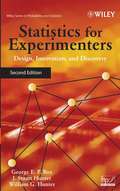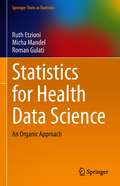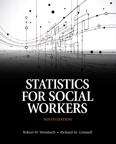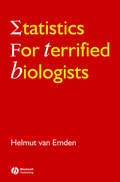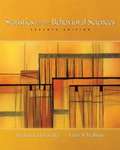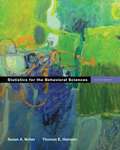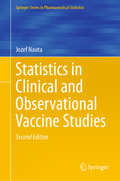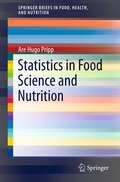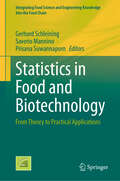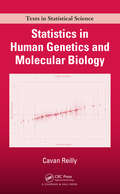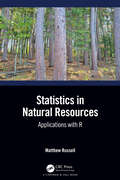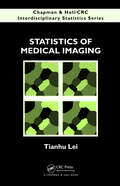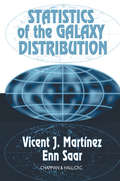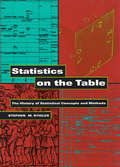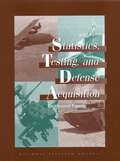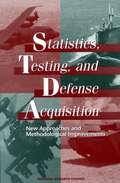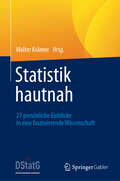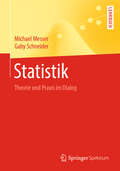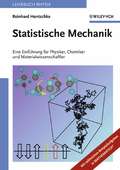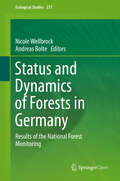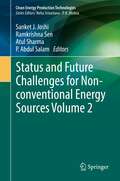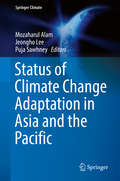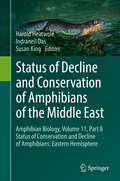- Table View
- List View
Statistics for Experimenters: Design, Innovation, and Discovery (Second Edition)
by George E.P. Box J. Stuart Hunter William G. HunterThe book intends to make available to experimenters scientific and statistical tools that can greatly catalyze innovation, problem solving, and discovery and illustrate how these tools may be used by and with subject matter specialists as their investigations proceed.
Statistics for Health Data Science: An Organic Approach (Springer Texts in Statistics)
by Ruth Etzioni Micha Mandel Roman GulatiStudents and researchers in the health sciences are faced with greater opportunity and challenge than ever before. The opportunity stems from the explosion in publicly available data that simultaneously informs and inspires new avenues of investigation. The challenge is that the analytic tools required go far beyond the standard methods and models of basic statistics. This textbook aims to equip health care researchers with the most important elements of a modern health analytics toolkit, drawing from the fields of statistics, health econometrics, and data science. This textbook is designed to overcome students’ anxiety about data and statistics and to help them to become confident users of appropriate analytic methods for health care research studies. Methods are presented organically, with new material building naturally on what has come before. Each technique is motivated by a topical research question, explained in non-technical terms, and accompanied by engaging explanations and examples. In this way, the authors cultivate a deep (“organic”) understanding of a range of analytic techniques, their assumptions and data requirements, and their advantages and limitations. They illustrate all lessons via analyses of real data from a variety of publicly available databases, addressing relevant research questions and comparing findings to those of published studies. Ultimately, this textbook is designed to cultivate health services researchers that are thoughtful and well informed about health data science, rather than data analysts. This textbook differs from the competition in its unique blend of methods and its determination to ensure that readers gain an understanding of how, when, and why to apply them. It provides the public health researcher with a way to think analytically about scientific questions, and it offers well-founded guidance for pairing data with methods for valid analysis. Readers should feel emboldened to tackle analysis of real public datasets using traditional statistical models, health econometrics methods, and even predictive algorithms. Accompanying code and data sets are provided in an author site: https://roman-gulati.github.io/statistics-for-health-data-science/
Statistics for Social Workers (Ninth Edition)
by Robert W. Weinbach Richard M. GrinnellThis book intends to be a reference for social work practitioners who, increasingly, are involved in agency-based research projects, and who must critically evaluate the reports of research findings in order to remain effective evidence-based practitioners.
Statistics for Terrified Biologists
by Helmut van Emden“We highly recommend it—not just for statistically terrified biology students and faculty, but also for those who are occasionally anxious or uncertain. In addition to being a good starting point to learn statistics, it is a useful place to return to refresh your memory.” –The Quarterly Review of Biology, March 2009 "During the entire course of my Ph.D. I've been (embarrasingly) looking for a way to teach myself the fundamentals of statistical analysis. At this point in my education, I've come to realize that often times, simply knowing the basics is enough for you to properly apply even the most complex analytical methods. ‘Statistics for Terrified Biologists’ has been just such a book - it was more than worth the $40 I spent on it, and while my 'book clubs' aren't meant to be reviews, I highly recommend the book to anyone who's in a similar predicament to my own." –Carlo Artieri's Blog Book Club The typical biology student is “hardwired” to be wary of any tasks involving the application of mathematics and statistical analyses, but the plain fact is much of biology requires interpretation of experimental data through the use of statistical methods. This unique textbook aims to demystify statistical formulae for the average biology student. Written in a lively and engaging style, Statistics for Terrified Biologists draws on the author’s 30 years of lecturing experience. One of the foremost entomologists of his generation, van Emden has an extensive track record for successfully teaching statistical methods to even the most guarded of biology students. For the first time basic methods are presented using straightforward, jargon-free language. Students are taught to use simple formulae accurately to interpret what is being measured with each test and statistic, while at the same time learning to recognize overall patterns and guiding principles. Complemented by simple illustrations and useful case studies, this is an ideal statistics resource tool for undergraduate biology and environmental science students who lack confidence in their mathematical abilities.
Statistics for the Behavioral Sciences
by Frederick J. Gravetter Larry B. WallnauMaster statistics with STATISTICS FOR THE BEHAVIORAL SCIENCES! With straightforward instruction, built-in learning aids, and real world examples, this psychology text provides you with the tools you need to succeed. You will have numerous opportunities to practice statistical techniques through learning checks, examples, demonstrations, and problems. Exam preparation is made easy with a student companion website that provides tutorials, crossword puzzles, flashcards, learning objectives, and more!
Statistics for the Behavioral Sciences (2nd Edition)
by Susan A. Nolan Thomas E. HeinzenIn this new edition, author tries to connect students to statistical concepts efficiently and refocuses on the core concepts of the course and introduces each topic with a vivid example.
Statistics in Clinical and Observational Vaccine Studies (Springer Series in Pharmaceutical Statistics)
by Jozef NautaThis book offers an overview of the statistical methods used in clinical and observational vaccine studies. Pursuing a practical rather than theoretical approach, it presents a range of real-world examples with SAS codes, making the application of the methods straightforward. This revised edition has been significantly expanded to reflect the current interest in this area. It opens with two introductory chapters on the immunology of vaccines to provide readers with the necessary background knowledge. It then continues with an in-depth exploration of the analysis of immunogenicity data. Discussed are, amongst others, maximum likelihood estimation for censored antibody titers, ANCOVA for antibody values, analysis of data of equivalence, and non-inferiority immunogenicity studies. Other topics covered include fitting protection curves to data from vaccine efficacy studies, and the analysis of vaccine safety data. In addition, the book features four new chapters on vaccine field studies: an introductory one, one on randomized vaccine efficacy studies, one on observational vaccine effectiveness studies, and one on the meta-analysis of vaccine efficacy studies. The book offers useful insights for statisticians and epidemiologists working in the pharmaceutical industry or at vaccines institutes, as well as graduate students interested in pharmaceutical statistics.
Statistics in Food Science and Nutrition
by Are Hugo PrippMany statistical innovations are linked to applications in food science. For example, the student t-test (a statistical method) was developed to monitor the quality of stout at the Guinness Brewery and multivariate statistical methods are applied widely in the spectroscopic analysis of foods. Nevertheless, statistical methods are most often associated with engineering, mathematics, and the medical sciences, and are rarely thought to be driven by food science. Consequently, there is a dearth of statistical methods aimed specifically at food science, forcing researchers to utilize methods intended for other disciplines. The objective of this Brief will be to highlight the most needed and relevant statistical methods in food science and thus eliminate the need to learn about these methods from other fields. All methods and their applications will be illustrated with examples from research literature.
Statistics in Food and Biotechnology: From Theory to Practical Applications (Integrating Food Science and Engineering Knowledge Into the Food Chain #16)
by Saverio Mannino Gerhard Schleining Prisana SuwannapornThe proper use of statistical methods is essential in food processing and biotechnology, and very few publications have focused on the practical application of these methods. This book utilizes case studies to explain the corresponding basics with a focus on understanding how and when to use the appropriate statistical methods. The text is structured according to practical applications, starting from data collection and data treatment, moving to product development, process control and analytical methods. Practical Examples of Using Statistics in Food and Biotechnology begins with a detailed introduction to statistics and their use in food processing. The first main section focuses on statistics for data collection and treatment featuring scales of measurement, sampling and summarizing and presenting data. Another section looks at statistics for food product and process development, examining mixture experiments for different food groups from meat and fish to vegetables, juices, rice and olive oils. Further sections focus on statistical process control, statistics for sensory science and a wide range of analytical methods including LC-MS/MS and other cutting edge methods. In providing practical, hands-on information on the use of statistics in food processing, this work will be of major importance for food professionals, industry staff and researchers in food and biotechnology. .
Statistics in Human Genetics and Molecular Biology (Chapman & Hall/CRC Texts in Statistical Science)
by Cavan ReillyFocusing on the roles of different segments of DNA, Statistics in Human Genetics and Molecular Biology provides a basic understanding of problems arising in the analysis of genetics and genomics. It presents statistical applications in genetic mapping, DNA/protein sequence alignment, and analyses of gene expression data from microarray experiments.
Statistics in Natural Resources: Applications with R
by Matthew RussellTo manage our environment sustainably, professionals must understand the quality and quantity of our natural resources. Statistical analysis provides information that supports management decisions and is universally used across scientific disciplines. Statistics in Natural Resources: Applications with R focuses on the application of statistical analyses in the environmental, agricultural, and natural resources disciplines. This is a book well suited for current or aspiring natural resource professionals who are required to analyze data and perform statistical analyses in their daily work. More seasoned professionals who have previously had a course or two in statistics will also find the content familiar. This text can also serve as a bridge between professionals who understand statistics and want to learn how to perform analyses on natural resources data in R. The primary goal of this book is to learn and apply common statistical methods used in natural resources by using the R programming language. If you dedicate considerable time to this book, you will: Develop analytical and visualization skills for investigating the behavior of agricultural and natural resources data. Become competent in importing, analyzing, and visualizing complex data sets in the R environment. Recode, combine, and restructure data sets for statistical analysis and visualization. Appreciate probability concepts as they apply to environmental problems. Understand common distributions used in statistical applications and inference. Summarize data effectively and efficiently for reporting purposes. Learn the tasks required to perform a variety of statistical hypothesis tests and interpret their results. Understand which modeling frameworks are appropriate for your data and how to interpret predictions. Includes over 130 exercises in R, with solutions available on the book’s website.
Statistics of Medical Imaging (Chapman & Hall/CRC Interdisciplinary Statistics)
by Tianhu LeiStatistical investigation into technology not only provides a better understanding of the intrinsic features of the technology (analysis), but also leads to an improved design of the technology (synthesis). Physical principles and mathematical procedures of medical imaging technologies have been extensively studied during past decades. However, les
Statistics of the Galaxy Distribution
by Vicent J. Martinez Enn SaarOver the last decade, statisticians have developed new statistical tools in the field of spatial point processes. At the same time, observational efforts have yielded a huge amount of new cosmological data to analyze. Although the main tools in astronomy for comparing theoretical results with observation are statistical, in recent years, cosmologis
Statistics on the Table: The History of Statistical Concepts and Methods
by Stephen M. StiglerThis lively collection of essays examines in witty detail the history of some of the concepts involved in bringing statistical argument "to the table," and some of the pitfalls that have been encountered. The topics range from seventeenth-century medicine and the circulation of blood, to the cause of the Great Depression and the effect of the California gold discoveries of 1848 upon price levels, to the determinations of the shape of the Earth and the speed of light, to the meter of Virgil's poetry and the prediction of the Second Coming of Christ. The title essay tells how the statistician Karl Pearson came to issue the challenge to put "statistics on the table" to the economists Marshall, Keynes, and Pigou in 1911. The 1911 dispute involved the effect of parental alcoholism upon children, but the challenge is general and timeless: important arguments require evidence, and quantitative evidence requires statistical evaluation. Some essays examine deep and subtle statistical ideas such as the aggregation and regression paradoxes; others tell of the origin of the Average Man and the evaluation of fingerprints as a forerunner of the use of DNA in forensic science. Several of the essays are entirely nontechnical; all examine statistical ideas with an ironic eye for their essence and what their history can tell us about current disputes.
Statistics, Testing, and Defense Acquisition: Background Papers
by Michael L. Cohen Duane L. Steffey John E. RolphThe National Academies Press (NAP)--publisher for the National Academies--publishes more than 200 books a year offering the most authoritative views, definitive information, and groundbreaking recommendations on a wide range of topics in science, engineering, and health. Our books are unique in that they are authored by the nation's leading experts in every scientific field.
Statistics, Testing, and Defense Acquisition: New Approaches and Methodological Improvements
by Michael L. Cohen Duane L. Steffey John E. RolphFor every weapons system being developed, the U.S. Department of Defense (DOD) must make a critical decision: Should the system go forward to full-scale production? The answer to that question may involve not only tens of billions of dollars but also the nation's security and military capabilities. In the milestone process used by DOD to answer the basic acquisition question, one component near the end of the process is operational testing, to determine if a system meets the requirements for effectiveness and suitability in realistic battlefield settings. Problems discovered at this stage can cause significant production delays and can necessitate costly system redesign.This book examines the milestone process, as well as the DOD's entire approach to testing and evaluating defense systems. It brings to the topic of defense acquisition the application of scientific statistical principles and practices.
Statistics, Testing, and Defense Acquisition: New Approaches and Methodological Improvements
by Panel on Statistical Methods for Testing Evaluating Defense SystemsFor every weapons system being developed, the U.S. Department of Defense (DOD) must make a critical decision: Should the system go forward to full-scale production? The answer to that question may involve not only tens of billions of dollars but also the nation's security and military capabilities. In the milestone process used by DOD to answer the basic acquisition question, one component near the end of the process is operational testing, to determine if a system meets the requirements for effectiveness and suitability in realistic battlefield settings. Problems discovered at this stage can cause significant production delays and can necessitate costly system redesign.This book examines the milestone process, as well as the DOD's entire approach to testing and evaluating defense systems. It brings to the topic of defense acquisition the application of scientific statistical principles and practices.
Statistik hautnah: 27 persönliche Einblicke in eine faszinierende Wissenschaft
by Walter KrämerWie funktioniert Statistik als Wissenschaft in Deutschland? Wer gibt den Ton an und wo findet der wissenschaftliche Fortschritt statt? Und wer sind die Menschen, die die Statistik in Deutschland in den letzten Jahrzehnten geprägt und angetrieben haben? In diesem Buch kommen 27 von ihnen in persönlichen Interviews zu Wort. Dabei wird schnell klar: Die Wege in die wissenschaftliche Statistik sind sehr vielfältig – und in aller Regel ungeplant. Dies macht es aber umso spannender, sich damit zu beschäftigen! Der inhaltliche Schwerpunkt des Buchs liegt auf Anwendungen in den Wirtschaftswissenschaften, doch natürlich erhält auch die mathematische Statistik als Lieferant der nötigen Werkzeuge einen Ehrenplatz. Wie kann Statistik helfen, Kapital- und Arbeitsmärkte, unser Renten- und Sozialsystem, die demographische Herausforderung oder die Einkommensverteilung besser zu verstehen? Wie und wo bekommt man die nötigen Daten her? Und welche neuen Chancen eröffnen sich durch das Vordringen der Informatik in dieser Wissenschaft? Hier öffnen die zuständigen Experten ihren persönlichen Erfahrungsschatz! Die Interviews – beginnend mit Heinz Grohmann im Jahr 2014 – wurden in unregelmäßigen Abständen in AStA Wirtschafts- und sozialstatistisches Archiv, einer der beiden Vereinszeitschriften der Deutschen Statistischen Gesellschaft, veröffentlicht. Für dieses Buch wurden sie thematisch geclustert und aus heutiger Perspektive erläutert und eingeordnet, so dass sich ein vergleichsweise umfassender und dennoch persönlicher Einblick ergibt. Drei ganz aktuelle Interviews sind exklusiv für diesen Band geführt worden.
Statistik: Theorie und Praxis im Dialog
by Michael Messer Gaby SchneiderDieses Lehrbuch ebnet Mathematik-Studierenden einen Weg in die Statistik, bei dem Theorie und Praxis statistischer Methoden gleichermaßen berücksichtigt werden: Anspruchsvolle mathematische Formulierungen werden konsequent dargestellt und im Rahmen von Beispielanalysen mit praktischen Anwendungen in Verbindung gebracht. Durch unterhaltsame und lehrreiche Dialoge zwischen theoretischen Statistikern und Anwendern (etwa Biologen) wird die Materie lebendig. Das Buch liefert zahlreiche Beispiele unterschiedlichen Detailgrads, bleibt aber trotz der theoretischen Tiefe übersichtlich und sprengt den Rahmen einer Einführung nicht.
Statistische Mechanik: Eine Einführung für Physiker, Chemiker und Materialwissenschaftler
by Reinhard HentschkeDas Lehrbuch ist der optimale Einstieg in die aktuellen Fragen der Thermodynamik und Statistischer Physik. Dabei vollzieht es einen Br ckenschlag zwischen Physik, Chemie und den Materialwissenschaften. Didaktisch besonders ergiebig sind die zahlreichen Beispielaufgaben (mit L sungen), wobei den numerischen L sungen die entsprechenden MATHEMATICA-Programme beigef gt sind. Damit ist der Band zugleich auch eine Einf hrung in die rechnergest tzten Methoden der statistischen Physik. Neben den Grundlagen des Fachs widmet sich das Buch Themen wie Phasen berg ngen, Systemen ohne direkte Wechselwirkung, Fluktuationen sowie Anwendungen von Monte-Carlo-Simulationen. Ziemlich umfangreich sind auch die Ausf hrungen zur Physik der Weichen Materie. Dies entspricht dem enormen Bedeutungszuwachs, den der Bereich in den letzten Jahren erlebt hat. Bei der Darstellung dieses Grenzgebiets zwischen Physik, Physikalischer Chemie und den Materialwissenschaften steht sein interdisziplin rer Charakter im Vordergrund. Studenten wie Dozenten d rfte die jederzeit klare und jederzeit verst ndliche Darstellung berzeugen. Aufgabenstellungen und deren L sungen sind die gro e St rke des Buches. Didaktisch besonders wertvoll werden diese nicht zuletzt durch die Integration von MATHEMATICA in die numerischen L sungen. So dienen die Aufgaben nicht nur der Vertiefung des Gelernten, sondern bieten Studenten auch Gelegenheit, sich mit rechnergest tzten Methoden der statistischen Physik vertraut zu machen. Und wer seine Kenntnisse dar ber hinaus erg nzen und vertiefen m chte, wird im kommentierten Literaturverzeichnis f ndig.
Status and Dynamics of Forests in Germany: Results of the National Forest Monitoring (Ecological Studies #237)
by Nicole Wellbrock Andreas BolteThis book is an open access publication.Forest ecosystems in Central Europe are changing as a result of anthropogenic influences and changing climate conditions. As such, a large-scale monitoring programme was undertaken in order to understand the influence of site modification, deposition of air pollutants, and climate. This book presents the scientific findings of this study for Germany, including the major challenges with regard to the future preservation and management of forest ecosystems under environmental change. In addition, it addresses a number of central questions: what are the main factors affecting forest stands and soil integrity? How, and how rapidly, are forest ecosystems changing? How diverse are the changes across Germany? What will be the main risks in sustainable forest management in the future? And how can policy support the development and maintenance of adaptive and resilient forests that provide essential ecosystem services, today and in the future? Helping readers understand the importance of soils and related ecosystem processes for future sustainable forestry, and sharing essential findings on environmental change and related changes in forest status and dynamics, the book is a valuable resource for researchers and policymakers interested in science-based decisions.
Status and Future Challenges for Non-conventional Energy Sources Volume 1 (Clean Energy Production Technologies)
by P. Abdul Salam Atul Sharma Ramkrishna Sen Sanket J. JoshiThis book highlights recent advancements in such an important topic, through contribution from experts demonstrating different applications in ‘day-to-day’ life, both existing and newly emerging non-biological technologies, and thought provoking approaches from different parts of the world, potential future prospects associated with some frontier development in non-conventional energy sources. It covers different types of natural energy sources such as: Ocean, Tidal and Wave energy; Nuclear energy; Solar cells; Geothermal energy; Hydrogen Fuel; Photovoltaic modules; Gas hydrates; Hydrate-based Desalination Technology; and Hydrothermal Liquefaction of Kraft Lignin/ Lignocellulosic Biomass to Fuels and Chemicals. This book is a comprehensive and informative compilation for international readers, especially undergraduate and post graduate students and researchers.
Status and Future Challenges for Non-conventional Energy Sources Volume 2 (Clean Energy Production Technologies)
by P. Abdul Salam Atul Sharma Ramkrishna Sen Sanket J. JoshiThis book highlights recent advancements in such an important topic, through contribution from experts demonstrating different applications in ‘day-to-day’ life, both existing and newly emerging biological technologies, and thought provoking approaches from different parts of the world, potential future prospects associated with some frontier development in non-conventional energy sources. It covers different aspects of cellulosic and lignocellulosic biomass; Cellulosics Biorefinery; Algal Biofuels; Biodiesel; Bioethanol; Microbial Fuel Cells; Biofuel cells; and biohydrogen production. This book is a comprehensive and informative compilation for international readers, especially undergraduate, post graduate students and researchers.
Status of Climate Change Adaptation in Asia and the Pacific (Springer Climate)
by Mozaharul Alam Jeongho Lee Puja SawhneyThis volume provides an overview of the climate change adaptation objectives set, actions taken, and challenges faced by several countries in the Asia-Pacific region. The majority of the populations in this region struggle to make a living from subsistence agriculture, and livelihoods are highly dependent on natural ecosystem services which are likely to be severely affected by climate change. Cases discussed in this book highlight successes made by governments towards achieving adaptation objectives, and efforts required to overcome challenges. While significant economic advances have been made, the pace of growth has been slow to impact the lives of a majority of the people who live below the poverty line. The chapters highlight adaptation actions for protecting people and their livelihoods in priority sectors, maintaining food and water security, supporting socio-economic stability including poverty reduction, and climate risk management. This book also maximizes readers' insights into the knowledge gaps and limitations of stated adaptation goals, and the bottlenecks that hinder implementation in different regions.
Status of Decline and Conservation of Amphibians of the Middle East: Amphibian Biology, Volume 11, Part 8 Status of Conservation and Decline of Amphibians: Eastern Hemisphere
by Susan King Indraneil Das Harold HeatwoleAmphibians by virtue of their thin, moist, permeable skins are poorly protected from harsh environments and are especially susceptible to chemical changes, desiccation, and alteration of their habitat. Accordingly, it is not surprising that they manifest exceptionally high rates of extinction and suffer more severe declines than do most other taxa in an environment undergoing unprecedented anthropogenic change. They are especially important to study as they serve as an early-warning system portending changes that are beginning to engulf more resistant species, including our own.The current volume covers the 14 countries of the Middle East, each written by a specialist, and is part of the Amphibian Biology series.
